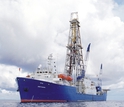NASA's OCO-2 Satellite on the Launch Pad
The launch gantry surrounding the Delta II rocket with the second
Orbiting Carbon Observatory satellite onboard is seen in this black and white
infrared view of Space Launch Complex 2 at Vandenberg Air Force Base, Calif.
The satellite will measure the global distribution of carbon dioxide, the
leading human-produced greenhouse gas driving changes in Earth’s climate. OCO-2
is set for a July 1, 2014,launch. Photo Credit: (NASA/Bill
Ingalls)
La NASA Lanzará un Nuevo Satélite Para Estudiar los Enigmas del Carbono, que tanto tienen que ver con el cambio climático de nuestro planeta...
La primera nave espacial de la NASA dedicada a medir los niveles de dióxido de carbono en la atmósfera de la Tierra, ultima los preparativos para su lanzamiento el próximo 1 de Julio, desde la Base de la Fuerza Aérea de Vandenberg, en California.
El Observatorio Orbital de Carbono-2 (OCO-2) proporcionará una imagen más completa y global de las fuentes de dióxido de carbono naturales y humanas, así como sus "sumideros", los procesos naturales del océano y de la tierra por los que este gas sale fuera de la atmósfera y queda almacenado. El dióxido de carbono, un componente crítico del ciclo del carbono de la Tierra, es el principal gas de efecto invernadero de origen humano.
"El dióxido de carbono juega en la atmósfera un papel fundamental en el equilibrio energético de nuestro planeta y es un factor clave en la comprensión de cómo está cambiando nuestro clima", dijo Michael Freilich, director de la División de Ciencias de la Tierra de la NASA en Washington. "Con la misión OCO-2, la NASA contribuye a una nueva e importante fuente de observaciones globales para el reto científico de comprender mejor nuestra Tierra y su futuro."
Los gases de invernadero atrapan el calor del sol dentro de la atmósfera de la Tierra, calentando la superficie del planeta y ayudando a mantener las temperaturas habitables desde los polos al ecuador. Los científicos han concluido que el aumento de dióxido de carbono de las actividades humanas, por la quema de combustibles fósiles y la deforestación en particular, ha desvirtuado el ciclo natural del carbono de la Tierra, provocando un aumento de las temperaturas superficiales globales y el cambio climático de nuestro planeta.
Fuente: www.lanasa.net Ver más
La primera nave espacial de la NASA dedicada a medir los niveles de dióxido de carbono en la atmósfera de la Tierra, ultima los preparativos para su lanzamiento el próximo 1 de Julio, desde la Base de la Fuerza Aérea de Vandenberg, en California.
El Observatorio Orbital de Carbono-2 (OCO-2) proporcionará una imagen más completa y global de las fuentes de dióxido de carbono naturales y humanas, así como sus "sumideros", los procesos naturales del océano y de la tierra por los que este gas sale fuera de la atmósfera y queda almacenado. El dióxido de carbono, un componente crítico del ciclo del carbono de la Tierra, es el principal gas de efecto invernadero de origen humano.
"El dióxido de carbono juega en la atmósfera un papel fundamental en el equilibrio energético de nuestro planeta y es un factor clave en la comprensión de cómo está cambiando nuestro clima", dijo Michael Freilich, director de la División de Ciencias de la Tierra de la NASA en Washington. "Con la misión OCO-2, la NASA contribuye a una nueva e importante fuente de observaciones globales para el reto científico de comprender mejor nuestra Tierra y su futuro."
Los gases de invernadero atrapan el calor del sol dentro de la atmósfera de la Tierra, calentando la superficie del planeta y ayudando a mantener las temperaturas habitables desde los polos al ecuador. Los científicos han concluido que el aumento de dióxido de carbono de las actividades humanas, por la quema de combustibles fósiles y la deforestación en particular, ha desvirtuado el ciclo natural del carbono de la Tierra, provocando un aumento de las temperaturas superficiales globales y el cambio climático de nuestro planeta.
Fuente: www.lanasa.net Ver más























